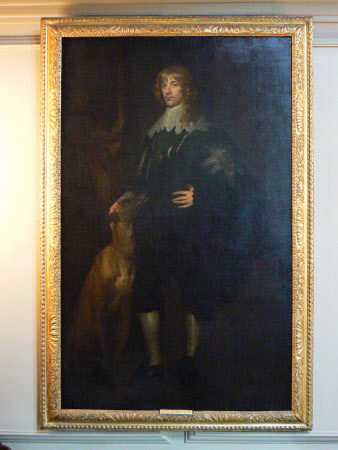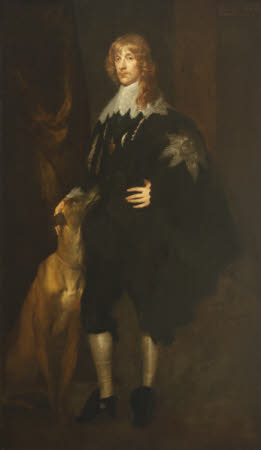James Stuart, 4th Duke of Lennox and 1st Duke of Richmond (1612-1655)
after Sir Anthony Van Dyck (Antwerp 1599 - London 1641)
Category
Art / Oil paintings
Date
1635 (after)
Materials
Oil on canvas
Measurements
2070 x 1283 mm (81½ x 50½ in)
Order this imageCollection
Ham House, Surrey
NT 1139643
Summary
Oil painting on canvas, James Stuart, 4th Duke of Lennox and 1st Duke of Richmond (1612-1655) after Sir Anthony Van Dyck (Antwerp 1599 - London 1641), after 1635. A full-length portrait of a young man, turned slightly to the left, gazing at the spectator, dressed in a black suit with slashed sleeves, large scalloped lace collar, and black cloak with a huge star of the recently (November 1633) conferred Garter over his left shoulder, and the lesser George hanging from a v-shaped blue ribbon, has his right hand on the head of a greyhound looking adoringly up at him, and his left hand on his hip; the corner of a wall is behind him to the right, and a curtain to the left. A close relative of Charles I and an ardent Royalist during the Civil War. Although Stuart was a contemporary of William Murray, this portrait is not listed at Ham before 1770. The original, of about 1634/35, is in the Metropolitan Museum of Art, New York. The preparatory study for the original full-length, in black chalk heightened with white on light brown paper is in the British Museum (1874-8-8-142). There are also two studies of the greyhound, in black chalk heightened with white on light brown paper in the British Museum (1874-8-8-141) (see exh. cat. by Lindsay Stainton and Christopher White, 'Drawing in England from Hilliard to Hogarth', British Museum, 1987, pp.86-89). A number of copies are listed by Oliver Millar in Van Dyck, 2004, pp.584 & 586, to which one might add a good early one, from the collections of the House of Orange, in the Dutch Embassy in London.
Provenance
Seen in house by Horace Walpole in 1770; acquired by His Majesty’s Government, when Sir Lyonel and Cecil Tollemache presented Ham House to the National Trust, and entrusted to the care of the Victoria & Albert Museum, until 1990, when returned to the care of the National Trust, to which ownership was transferred in 2002.
Credit line
Ham House, The Dysart Collection (purchased by HM Government in 1948 and transferred to the National Trust in 2002)
Marks and inscriptions
Verso: on a printed label: SIR L. TOLLEMACHE / No.1; as a black stencil: B / 1492 [knulled panel frame, 17th-century (as on Lady Poulet, HAM.P.228)]
Makers and roles
after Sir Anthony Van Dyck (Antwerp 1599 - London 1641), artist
References
Walpole 1770 in Horace Walpole 'Journals of visits to country seats, &c.' ed. Paget Toynbee. Vol. 16. Walpole Society, xxxiv, 1927-8. [Ham House, 10th June 1770 pp.67-68]

